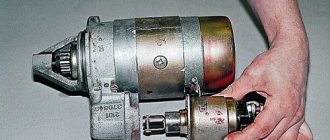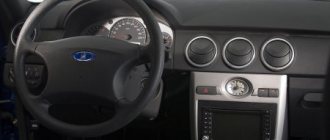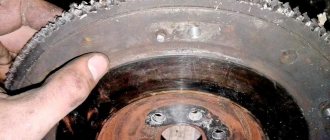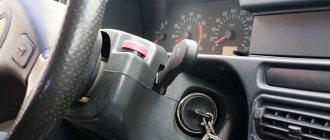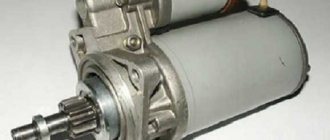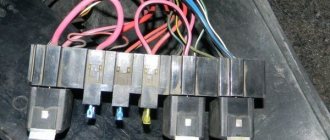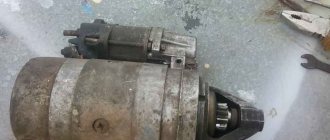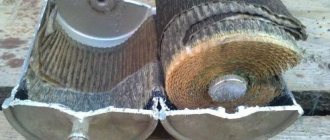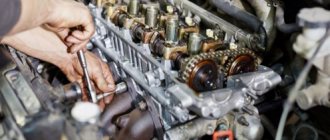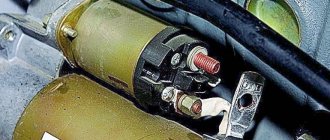Published:
18.01.2017
We take the health of our car for granted. The times when we spent as many hours under the car as in the cabin are, fortunately, gone. And when, when we turn the key in the ignition, we don’t hear the usual hum of a running engine, we become perplexed: what happened, the battery is dead, the starter takes over the current, how can we find out? If you know for sure that your battery is almost new and was fully charged, then, obviously, there is reason to blame the starter.
Self-diagnosis
In order to find the cause of a mechanism malfunction, you need to understand how it works, know how the starter is connected, and how to check all its elements for serviceability.
Trigger device
The device consists of a large number of parts, but its basis is:
- electric motor;
- bendix;
- solenoid relay.
With the help of an electric motor, the energy received from the battery at start is transferred through the gear to the engine crankshaft. The starter is an electromechanical device, so it can have both mechanical and electrical faults.
It is necessary before the motorist wants to take active action. If you can identify the reasons for this behavior of the starter, then they can be eliminated right on the spot, without even going to a car service center and without wasting extra time. The basics of starter repair teach us that the most complex breakdowns are the following:
- The starter relay has failed;
- The solenoid relay has deteriorated;
- The bendix is worn out;
- The starter winding is burnt out.
Why does drawdown occur?
An inexperienced motorist, as a rule, when faced with a starter problem, rushes to specialists. The service station immediately makes a disappointing diagnosis - the starter is taking on excess voltage. However, no one will explain the reasons for this behavior of the starter.
So, in most cases, drawdown indicates such problems.
- The starter bushings are worn out and short to the housing, which causes the moving parts to jam (and, accordingly, the starter takes over).
- There is poor contact in the ignition system wiring.
- The resistance of the crank shaft increases or decreases, which is explained by a short to ground or incorrect selection of oil.
- If the gearbox is poorly lubricated, this can also cause subsidence.
Article on the topic: Balancing the flywheel in the garage yourself
More details about this in the table below.
| Starter failure | KVSh shaft resistance |
| Bushing wear | Engine oil that is too viscous |
| Jamming of moving parts | Incorrect selection of crankshaft liners |
| Short circuit between the turns of the windings or to the housing | Errors during engine repair |
Checking the starter using the battery
Okay, our battery is in good working order and we fully charged it the day before, how can we find out if the starter is taking over, and by what signs can we determine this? The most obvious symptom: if, when turning the ignition key, the light bulbs that are powered from the on-board network lose brightness and sometimes go out, this is a sign that there is a current drawdown in the system, that is, the starter takes on excess energy.
This characterizes the state of the starting device of the power unit, in which it consumes a large amount of current from the power source (from 200 Amperes), while it cannot crank the engine crankshaft the number of times necessary to start it. A similar situation is observed when the starting current is insufficient.
To fully answer this question, there is no way to do without understanding how a car starter works. It is especially important to navigate the characteristics of this electrical appliance and not confuse them with each other. After all, a good half of car enthusiasts, watching the voltage drop on the voltmeter, think that the starter takes over the volts. Others speak correctly - about current. But what kind of current this is, and where the starter goes when it “takes over” - not everyone has a clear idea.
Starter power is a value that directly determines how quickly it can crank the engine during startup. The larger it is, the faster and easier the car starts. If there is not enough power, the starter turns sluggishly, jerkily, or even stops without starting the engine.
In turn, the power of the starter is directly proportional to the voltage (volts) in the circuit in which it operates and the current (amps) it consumes. The higher the voltage and current, the greater the power. And this rule is true both for a working starter and for one that “takes over”.
Now that there is a clear understanding of what a diagnosis of “starter taking over” means, let's look at the main symptoms that indicate this problem. Let's list them, and then go through each point for greater clarity:
- difficult or unsuccessful engine starts;
- noticeable voltage drop;
- increased starting current;
- starter overheating;
- characteristic smell of burnt wiring.
The very first symptom of a starter taking over is unsuccessful or difficult starting of the engine. Its nature is already clear to us. The starter consumes electricity, but does not convert it into useful work. As a rule, this symptom is observed on both a cold and warm engine.
The voltage drop during operation of the take-over starter can be visually determined without instruments. This is clearly visible from the control lights on the panel. It should be noted, however, that with LED lamps installed in the instrument panel, a similar effect may not be observed. The voltage drop is determined more accurately and clearly using a voltmeter. It can be installed in a car, or connected separately to the battery terminals.
A normal drop during the starter is considered to be a voltage drop of up to 11.5 V. If the device shows less when starting the engine, it is possible that the starter is taking on a lot of current. Why “possibly” is explained below.
An increased starting current cannot be determined without a special device. It's called a current clamp, and it allows you to record current strength that is much greater than a standard multimeter can. The normal starting current varies from vehicle to vehicle. Therefore, in order to draw conclusions based on this criterion, you need to know how much a working starter consumes on the same machine with a similar engine. For example, to start a gasoline engine with a volume of up to two liters, the starter needs 100-120 A.
Overheating of the starter and the characteristic burning smells can be detected after several unsuccessful engine starts. A properly working starter should not have time to heat up in the few seconds during which it operates. At the same time, it shouldn’t stink either.
The lack of power from the starting device of the power unit is due to a phenomenon in which the value of the starting current significantly increases or decreases. This can be caused by a lack of ground, burnt contacts, or unsatisfactory condition of the battery. To fix this you need to follow these simple steps:
- restore contact conductivity;
- charge the power source.
The malfunction can be caused by poor operation of the traction relay; to diagnose and eliminate it, you will have to remove the part from the car. In any case, the cause of this phenomenon is not so significant, so a motorist of any level can independently eliminate it. But, do not forget that in most cases, experienced car owners recommend simply replacing the starter.
Many drivers know what it means to not start the engine on the first try, and sometimes to a complete failure of the ignition system. There are many reasons for system failure, since many elements are involved in the operation of the ignition system. One of these “participants” is the starter. In this article we will look at a breakdown case and find out why the starter takes over the current and how to deal with it.
Thanks to the starter, the car engine starts. It receives power from the battery. If the starter does not work or rotates at low speeds, you should check the battery and wiring.
Starter connection diagram
The following malfunctions are possible:
- battery is low;
- the terminals are poorly secured or the contacts on the battery have oxidized;
- poor contact on the solenoid relay;
- damage to the electrical network in the area between the starter and the battery;
- The contact group of the ignition system does not work.
It is possible that the engine starts, but the starter does not turn off; in this case, there may be several reasons:
- bearing wear;
- wires jam on the shaft;
- jamming in the ignition switch.
Failures are eliminated by replacing faulty parts. If the drive gear becomes disengaged, extraneous noise may appear during operation of the trigger mechanism (video author: Irina Kuzilova).
Since the starter experiences heavy loads when turning the shaft and starting the piston group of the power unit, it should be regularly diagnosed to identify malfunctions.
Thanks to the starter it is possible. It receives power from the battery. If or rotates at low speeds, you should check the battery and wiring.
If the starter does not turn on, the cause may be a faulty relay or a short circuit in the windings of the device itself. If, when the armature rotates, the crankshaft does not rotate, it is possible that the clutch is slipping or the screw thread drive is running tight.
Now let's look at the reasons why the starter can take on a lot of current. As with the symptoms, let’s list them, and then go through each item separately:
- poor contact;
- clogging or wear of bushings;
- brush wear;
- collector clogged;
- short circuit in the windings;
- shedding of magnets;
- It's not the starter that's at fault.
It’s probably worth starting with the last point, since it is special and does not apply to starter failures. The fact is that the starter can take on a lot of current, sag voltage, rotate “tightly” or not work at all, even in fully working condition. Therefore, before starting to diagnose it, it is worth ruling out other possible causes of the problem. Let's look at them.
First of all, this concerns the battery. If it is, as they say, tired, discharged, with shorted banks, and so on, then the starter will not turn vigorously. In this case, you can make sure that it is working properly by measuring the starting current using a current clamp. If the battery is “weak”, then the voltage drop will be noticeable, but you will not find an increased starting current. Rather, on the contrary, the current will be very small.
Read more: Why is the engine idling high?
The second reason why a good starter takes a lot of current is the engine. It can create such mechanical resistance when starting that the starter simply “doesn’t have enough strength” to turn it normally. This happens if something gets stuck in the engine, the engine oil is too viscous, something gets stuck, and so on. It is quite difficult to identify such problems. However, they will have to be looked for if further testing of the starter shows its full suitability.
Now as for the starter itself. Let's go through the list. If there is poor contact in the starter wiring, it will not work fully. This problem should be looked for at the main terminals (on the battery), as well as at the starter terminals, which are located on the solenoid relay. Connections must be clean, free of oxides, rust and other dirt, and securely fastened.
Symptoms of a faulty starter
If the car does not start, then the problem may be in the starter.
Well, our battery is in good condition and the day before we fully charged it, how can we find out if the starter is taking over, by what signs can we determine this? The most obvious symptom: if, when turning the ignition key, the light bulbs that are powered from the on-board network lose brightness and sometimes go out, this is a sign that there is a current drawdown in the system, that is, the starter takes on excess energy. A similar situation can arise not only in the cold season, and it indicates a malfunction of the starter. However, this is only one external symptom, with the help of which we can only assume a malfunction. But where did it come from, why does this happen?
What to do in such a situation
Unfortunately, in most cases, this problem, one way or another, can only be solved with the help of medical intervention followed by an autopsy of the “patient.” Depending on the degree of “neglect” of the problem, they resort to both preventive and surgical treatment methods.
The first method is applicable when the mechanical parts of the Bendix drive have acceptable wear, but lack lubrication. All joints should be disassembled, washed with gasoline and lubricated with graphite lubricant. The Bendix gear and overrunning clutch are also lubricated. If the starter is geared, it is advisable to lubricate the planetary gear and all other drive gears.
If the brushes are “covered,” they naturally change. But, more often than not, the repairs are not limited to this. Being in a deplorable state, they probably took quite a beating on the collector. If it is black, burnt, with marks and scratches, then so be it. To get it into working condition, you can use a regular eraser, preferably a slightly worn one.
The eraser should be applied to the commutator and, evenly turning the armature, bring it to working condition. It is not recommended to use sandpaper in this case, since its abrasive material has a detrimental effect on the wear resistance of the presented units.
When the armature bushings wear out, they are replaced, unless, of course, it is too late and the armature has not crushed the seats. Sometimes it happens. For this purpose, you can use several methods. Most often, a tap of the appropriate diameter is used. By gradually screwing it into the cavity of the sleeve, it will painlessly leave its habitable place. Some car enthusiasts use a drift. It is placed over the bushing and hit with a hammer.
Such a bushing costs mere pennies, but untimely replacement can significantly hit the owner’s wallet.
At the moment there is a division of starting values into gasoline and diesel units. After all, a diesel engine initially needs a higher indicator, because its compression ratio is much higher, can reach up to 20 atmospheres.
For gasoline options this is 255 Amperes
For diesel options - at least 300 Amperes
These figures, as they say, were measured at minus 18 degrees Celsius, which may not be enough when starting in severe frosts.
But now, with the development of technology, we can often see starter current indicators in stores of 400, 500 and even 600 Amperes! What happens if you take these numbers? Am I burning my starter?
The answer is simple - of course not. Don't burn it! Take it and forget what a cold start is, with such characteristics you won’t care about any frost.
Of course, you need to read the characteristics of your car, but I think a starting value of 450 - 500 AMPERES will be enough for all regions of Russia. Again, I’ll make a reservation, I’m now considering ordinary cars, not trucks, with large and high-volume engines; often even 600 will not be enough for them.
How to check if the starter is working
The reasons have been decided. What to do if the starter takes on all the current? Is it possible to solve the problem on your own without bothering specialists at the service station?
As a rule, in most cases it is enough to simply clean the contacts along the entire chain. You should start with the battery terminals and end with the starter itself. If the problem does not go away, you need to go deeper. It is possible that the contacts inside the starter are clogged, which can also cause such a malfunction.
A standard voltmeter is a must-have tool used for testing. It is not necessary to remove the starting device from the car to begin with.
Here's what we recommend:
- connect one of the tester probes to the battery positive (it goes to the starter relay clamp), the other to ground (any part of the body);
- the display of the device should show values of 12 V (slightly more or less), and at the same time the starter should click characteristically, which will indicate the good condition of the battery.
If the display shows other values, for example, low - 10 V and below, then the reason for the drawdown is clearly in the ignition system.
Check directly
Checking the starter directly
In most cases, experts recommend running the voltage directly. In other words, the wire leading to the ignition should be disconnected from the solenoid relay, and the positive terminal should be short-circuited using a wrench. If the starter starts the engine, there is a problem with the relay or ignition switch. If the engine does not start anyway, the problem is already in the starter itself.
Relay testing is carried out on a completely clean unit. In other words, the solenoid relay should be thoroughly cleaned of dirt, dust and oil. Then place the starter (previously dismantled) on the battery, connecting the plus to the relay output, and the minus to the housing. If the starter starts to rotate normally, then the relay is working properly. If not, then you will have to change the traction unit to a new unit, always of the same model.
The starting device is also checked if its gears do not move when current is supplied from the battery. After all, it is possible that the solenoid relay is working properly, but it is the starter that is acting up. You can verify this like this:
- take a tester;
- check the current between the winding and the rotor.
Indicators less than 1 million ohms will prove the fact that the starter armature needs to be replaced.
As a rule, if several elements of the starter become unusable at once, then it is better to replace the entire starter. A detailed repair can cost much more than a major replacement.
It is already becoming clear how to determine whether the starter is taking over the current. In auto electrics, this process is usually called “PPT” or simply increased starting current. In this situation, the starter consumes at least 200 A of current, but is not capable of turning the crankshaft flywheel. Interestingly, a similar situation occurs when there is insufficient voltage, for example when the car battery is low. Thus, both values of non-standard current have an equally bad effect on engine starting.
Take a final look: why the starter takes over the video
Tired of paying fines? There is an exit!
Forget about fines from cameras! An absolutely legal new product - Traffic Police Camera Jammer, hides your license plates from the cameras that are installed in all cities. More details at the link.
- Absolutely legal (Article 12.2);
- Hides from photo and video recording;
- Suitable for all cars;
- Works through the cigarette lighter connector;
- Does not cause interference to radios and cell phones.
Almost every motorist may encounter a situation where the car eraser can begin to take over the current. There is little pleasure in this moment, especially since this can lead to the fact that the battery simply begins to discharge much faster. Most motorists are very lost in this case and, instead of figuring out the problem, they immediately rush to seek help from specialists.
First of all, it is important to understand that a certain amount of energy is required to start the engine. It is due to this that the starter is activated. When the brightness of the lighting on the dashboard decreases significantly at the moment the engine starts, this may be the first sign that the starter is taking over the current.
In addition, this can be determined through another simple manipulation. To do this, you need to listen to exactly how the starter rotates when you turn the ignition key. If the starter rotates sluggishly or even on the verge of stopping completely, this may also indicate that it is taking over the current.
- There are mechanical problems inside the starter;
- There is damage in the ignition system components or in the wiring itself.
Read more: BMW concept cars that reached mass production || BMW 9-Series Concept
In the case when everything is in order with the wiring, and the battery is fully charged, the engine will start quickly. If any of these violations are present, the starter can function, but at the same time it will take an excessive amount of energy for its work.
If it is possible to discover that the starter really takes on a lot of energy, first of all the motorist will need to clean all the network contacts. In some situations, stripping the battery terminals alone may be sufficient. If after cleaning the contacts the problem does not disappear, then you need to remove the starter and disassemble it.
- Excessive wear on starter bushings;
- Jamming of some parts inside the starter;
- Short circuit between windings;
- Creation of resistance by the crankshaft.
As for the latter, resistance is mainly created if the oil used by the engine is too viscous. In some cases, this can also be caused by incorrectly selected crankshaft liners, as well as improperly performed engine repairs.
There is a situation where the starter takes over the current and ultimately this leads to the battery being discharged faster. This situation frightens many people and they immediately go to a service center, but in fact, the problem when the starter drains the battery too much is not very serious and you can fix it yourself.
The starter is not so simple and there is usually no time to study its design, because the main thing is that it works correctly, especially at the moment when you need to drive the car somewhere. As for repairing the starter, it is quite simple if you know what to do, it’s just inconvenient to remove it from the engine, and repairing it is relatively not difficult.
The starter takes current: what to do in this case?
If it is possible to discover that the starter really takes on a lot of energy, first of all the motorist will need to clean all the network contacts. In some situations, stripping the battery terminals alone may be sufficient. If after cleaning the contacts the problem does not disappear, then you need to remove the starter and disassemble it. In this case, it is important to carefully inspect it for contamination of the brush assembly and other contacts. But generally in cars, the starter begins to take over the current if the following phenomena occur:
- Excessive wear on starter bushings;
- Jamming of some parts inside the starter;
- Short circuit between windings;
- Creation of resistance by the crankshaft.
As for the latter, resistance is mainly created if the oil used by the engine is too viscous. In some cases, this can also be caused by incorrectly selected crankshaft liners, as well as improperly performed engine repairs.
More information about how you can check the starter will be described in this useful video:
Published: September 20, 2022
problem with ZIL starter | Topic started by: Korbin
got a job at a new place. Igor (Yanira) POOR WEIGHT OF ENGINE FRAME.
Vladimir (Volker) added another wire from the engine to the frame - it didn’t help
Yakov (Jennica) did not change the batteries??
Vladimir (Volker) no. I have a new one, changed it in the spring, density 1.28
Yakov (Jennica) Vladimir, slip your starter into another zil and see how it is, don’t get into the wiring (clean the thick wires))) breakdowns to positive ground, maybe where the insulation is cracked and breakdowns through the dirt
Yakov (Jennica) on two MAZs it’s the same crap, one is 500, the other mine is newer, both have new ones (albeit strange batteries) the same story for 500 for about a month and a half and everything has been on mine for half a year and the khan doesn’t work.
Vladimir (Volker) Yakov, I already removed the starter from the worker, he had no problems. So I'll look at the wires. only it’s probably in the spring, because we’re installing them outside, and the towers won’t fit into the boxes. Thank you
Yakov (Jennica) Vladimir, good luck,
Azamat (Eachann) Vladimir, Good afternoon! I have the same problem, the starter takes over by turning the handle
Alexander (Amaron) Azamat, Yakov, Vladimir, are there other options, the same nonsense?? !
Azamat (Eachann) In general, the problem has been solved. Cleaned the contacts to ground. From the engine, gearbox. From the storter I also threw a lot onto the frame. And I turned the ignition on, it seemed to be successful) it starts with half a kick. Try)
Dauren (Adorjan) Hello everyone. Help with advice gur zila refuses to work when the engine is hot. What oil to fill
How to know that “the starter is taking over the current”
We take the health of our car for granted. The times when we spent as many hours under the car as in the cabin are, fortunately, gone. And when, when we turn the key in the ignition, we don’t hear the usual hum of a running engine, we become perplexed: what happened, the battery is dead, the starter takes over the current, how can we find out? If you know for sure that your battery is almost new and was fully charged, then, obviously, there is reason to blame the starter.
The starter takes over the current - what does this mean and what is the cause of the malfunction?
Hello, dear motorists! Nothing cheers up our fellow car enthusiast more than starting a car engine with the first turn of the key in the ignition.
If several attempts to start the car do not lead to the desired result, the mood is ruined for a long time. The car starting system, as it seems to drivers, is quite complicated and there is no desire to understand it.
As soon as problems arise with leaving the garage, we begin to look for a familiar “specialist mechanic”. Although difficulties that often arise can be eliminated in a matter of seconds with your own hands.
It is necessary to delve into the design of the starter and other parts that are involved in the engine starting procedure for the simple reason that the machine may be needed very urgently.
Often breakdowns occur far from service centers and experienced garage neighbors who can give practical advice or help. In fact, the biggest problem in repairing the starting system is the procedure for removing and installing the starter, since it is installed in a very inconvenient place. The rest is a matter of technique.
Why does the starter take over the current and how does this happen?
The difficult process of starting the engine leads us to service technicians, where knowledgeable specialists, without looking, say, “The starter takes over.” At this moment you feel a certain awkwardness, as even more questions arise.
Firstly, it is not at all clear what exactly the starter takes on? Secondly, why does he behave this way and what to do about it. After some time, it becomes clear that the “specialists” mean the starter’s inrush current.
Obviously, to start the engine, the starter needs a certain amount of electrical energy, the reserve of which in the battery ensures repeated starting of the engine. A clear sign of increased energy consumption is a significant decrease in the brightness of the lighting bulbs and dashboard displays.
Understanding the essence of the ongoing processes leads to three different options for possible problems:
- poor contact of electrical wiring and ignition system elements;
- low electrical resistance;
- high mechanical resistance.
If there is a charged battery and reliable connection of all systems, absolutely nothing prevents an absolutely serviceable starter from performing its function. However, as soon as some obstacle gets in the way, he also tries to do his job, but with much greater energy consumption.
What to do if the starter takes on a lot of energy?
If the starter takes on a lot of current, then it is impossible to say unequivocally about the reasons for this phenomenon and, accordingly, there is no, and there cannot be a universal recipe for treating this “illness”.
However, we can say that in most cases, a simple cleaning of the electrical circuit contacts, starting from the battery and ending with the final electrical device, helps to cure such a malfunction, like this and many others.
If cleaning the contacts did not help, then you will have to look deeper. It should be borne in mind that clogging of the brush assembly and contact groups inside the starter or retractor relay also often causes malfunctions of the starter.
Mechanical obstacles in the operation of the starter can be due to two groups of reasons:
- breakdown of the starter itself (more often it is wear of the starter bushings and jamming of moving parts, less often - a short circuit between the turns of the windings or to the housing);
- resistance of the engine crankshaft (in this case, the culprit may be too viscous engine oil, incorrect selection of crankshaft liners, or errors during engine repair).
It is clear that to repair most breakdowns, you will have to remove and disassemble the starter, and also seek help from specialists who, using special instruments, will be able to assess the condition of the starter windings and other parts.
Detailed video on how to close the starter with a screwdriver
Thus, it is possible to start a car engine if the traction relay or the starting device winding is faulty. This method is considered the most common among motorists. In order to start the starter from the pushrod, you will need a couple of assistants who will push the car, resting their hands on the trunk. At this time, the driver engages first gear and turns the key in the ignition. The starter should start the power unit.
Note that the greater the acceleration of the car while pushing, the faster the engine starting device will begin to spin its crankshaft, and the faster the car will start.
This measure should be resorted to in the event of a malfunction of the traction relay. This is evidenced by a characteristic clicking sound in the engine compartment when turning the key in the ignition switch, when the relay is turned on, while the starter cannot give the crankshaft the required number of revolutions to ensure the engine starts due to the fact that the drive gear does not engage with the flywheel .
Why does the starter take on a lot of current, how to check
All possible causes of the presented malfunction, one way or another, consist of two factors:
- mechanical;
- electric.
Both are closely related. In other words, mechanical wear can lead to electrical failures. Electrical faults can cause mechanical damage.
If you urgently need to drive, but the car engine does not start, the starting system cannot correctly perform its function, you should know why such a situation arises, in particular, the reason why the starter takes on a larger amount of starting current than it needs.
A common consequence of this is the heavy movement of the element shaft, the dim light of the indicators on the instrument panel when the ignition key is turned. Note that the starter can turn hard without consuming much starting current, so it is necessary to distinguish between these states of the starting device.
What does the concept of “increased starter inrush current” mean?
This characterizes the state of the starting device of the power unit, in which it consumes a large amount of current from the power source (from 200 Amperes), while it cannot crank the engine crankshaft the number of times necessary to start it. A similar situation is observed when the starting current is insufficient. Accordingly, the car engine cannot start due to the fact that its starting device consumes either too much or insufficient current for this.
Why does the starter take on increased current, or is its value insufficient to perform a normal start of the power unit? This phenomenon can be determined by the brightness of the indicators located on the dashboard at the moment the starter shaft is turned with the ignition on. If their brightness has noticeably decreased, therefore, a large amount of current is supplied to the device, but if the brightness remains the same, while the characteristic sounds of the starting system are not heard from the engine compartment, then the starter receives an insufficient amount of starting current, or does not receive it at all.
Advice! The design of dashboard indicators in modern vehicles contains LEDs, which may not react in any way when the current and voltage changes, continuing to glow with constant brightness. Therefore, to determine current sags, you need to use a multimeter.
Scheme, theory and practice
Let's see what the wiring diagram of any electric starter looks like. Contact B is constantly supplied with voltage.
Starter and its external circuits
In the diagram we see three “positive” contacts and one negative (8), which is always connected to the body. What needs to be closed:
- Before closing the starter, locate the S terminal. It is often made in the form of a petal;
- How to distinguish between contacts B and M: the first will have potential “12”;
- You need to close contact B with terminal S. This is done briefly and after turning on the “neutral”;
- Contacts M and B cannot be closed.
We move from theory to practice. On a VAZ-2114 car everything looks simple.
https://www.youtube.com/watch?v=H7k6u1e25EU
Solenoid relay VAZ-2114
Terminal B here is covered with a rubber band, and petal S is in contact with the terminal in plastic. The plastic plug is removed before “shorting”.
Closing the starter contact with a screwdriver
Explanation of symbols:
- B – Bold, “thick” wire;
- M – Motor (electric motor);
- S – Start.
A few words about the structure and properties
Batteries were created specifically to recharge and start the car, that is, they are very practical from the point of view of operation. A regular battery discharged very quickly, and it was expensive to change it; that’s when batteries were invented.
Through trial and error, batteries evolved - so a few years after the invention, a very specific model emerged, this was about 100 years ago, which has not changed until now.
Usually these are six compartments with plates made of lead (negative) and its oxide (positive), which are filled with a special electrolyte made of sulfuric acid. It is this combination that makes the battery work; if one component is excluded, the operation will be disrupted. One scattered battery generates an average of 2.1V, this is extremely little to start the engine; in an average battery, they are combined by connecting them in series, usually 6 banks of 2.1V = 12.6 - 12.7V. This voltage is enough to excite the starter winding.
Proven ways to close the starter directly: recommendations from the pros
Starter connection diagram
No less efficient and even more reliable, but you need another machine more powerful than your car. It will be enough to tow the vehicle for a short distance, and then start the engine in the same manner as described above. In this case, I would like to give a couple of practical tips:
- Do not turn off the car after it has started and then go straight to the service center;
- Do not forget that after starting the car, it will pick up speed if it is in second gear and you press the accelerator pedal;
- Don’t forget that after starting, the car towing you will stop. Therefore, you will need to have time to slow down.
Read more: Homemade generator from a starter with your own hands, which diode to install, instructions and video
Important! This method is not suitable for vehicles equipped with an automatic transmission, since due to certain features of its design, towing the vehicle is strictly contraindicated.
To implement this method, you will need a tow rope and another car. It is extremely important to strictly follow the following sequence of actions during towing:
- the leading machine should start moving smoothly and start moving at low speed to tension the cable;
- the driver of a towed car should not brake sharply;
- after the vehicle starts, it will begin to accelerate sharply;
- you should stop only after the leading car stops;
- Do not turn off the engine while unhooking the cable, otherwise it may not start, and towing will be required again.
What is the best way to close the starter - a screwdriver, a wrench or a pry bar? Let us note right away that a mount is an option for a rainy day when you don’t have a screwdriver or a key at hand. As a rule, a screwdriver and a wrench help in cases where the relay is faulty. The characteristic clicks coming from under the hood when turning the key in the ignition are full confirmation of this.
The Bendix gear is not able to turn the crankshaft because the relay does not provide enough energy. It remains to close the starter, giving voltage directly to the windings. As mentioned above, it is advisable to arm yourself with a large screwdriver or wrench that would reach both power terminals of the relay in order to bridge them.
Don’t forget to set the gearbox lever to idle and tighten the handbrake all the way. The key in the ignition switch must be turned half a turn so that the corresponding lights on the instrument panel come on. A screwdriver attached to the terminals in this case works like the relay itself. The method, as we see, is not tricky.
But you must always be on your guard. The fact is that you can damage the coil. It easily fails if you do this several times in a row. It’s just that on classic contact systems the coil does not have the appropriate protection, as on non-contact systems. To protect the coil from burning out, it is recommended to do the following:
- Ask the assistant to get into the car;
- Have him put the ignition key in the ignition position while you close the contact.
A very common problem in VAZ cars is that the car suddenly stops starting, the starter does not respond to the key. Let's try to close the starter directly. Let's fix the car on
, put the box in the “neutral” position. Open the hood and remove it for convenience
and we see the starter contacts.
The starter was closed directly, and after that, as you can see, the car started up instantly. This method will help you start your car when diagnostics and repairs are not possible. There can be many reasons for such a breakdown, we will not dwell on them, we will do a separate lesson later in which the problem will be examined in more detail. For those who don’t understand how to close the starter directly using our picture, watch the video below, it’s very simple.
After you closed the starter directly, the car started, then you turned it off again. You can try to start it again with the key, in most cases you will succeed, this is what happened with us.
Most car owners are aware of an unexpected situation when the vehicle engine does not start. Usually, the starting device is to blame, so it would be a good idea for the driver to know how to close the starter directly to start the car. Before performing the procedure, you need to learn to distinguish all the breakdowns of this unit that will require closing the starter, and become familiar with the methods for diagnosing them.
How to check: is the starter taking on increased starting current, and what to do in this situation?
Let's consider ways to detect this phenomenon and options for eliminating them:
- When you turn on the ignition, the indicators glow with constant brightness, but when you turn the starter with the key, nothing happens and all the indications go out. Oxide deposits may have accumulated on the power supply terminals and are causing poor contact. It is enough to simply sand them, then degrease them with any solvent and tighten them well.
- While performing a similar procedure, the engine starter cranked the crankshaft heavily a couple of times, after which it died down. In this case, the starter does not take on enough starting current, or there is no ground in the vehicle’s electrical network. How to find out what exactly is causing the current leakage? To do this, you will need a wire at the ends of which there are “crocodile clips” (these are usually used to light car batteries). One of its contacts must be secured to the negative of the battery, and the other - in any convenient place on the car body. If the power unit starts after this, the reason has been found.
- Heavy movement of the starter shaft, caused by a significant decrease in voltage in the on-board network (up to 9V and below), is often a signal to replace the power source. This can be determined by installing a working battery with a good charge in the car. If the engine started successfully, then the battery needs to be replaced. There is one more nuance: after installing the test power source, you need to measure the voltage at its terminals after starting the power unit. A generator malfunction is indicated by its value being less than 12.6V, but if the generator is functioning correctly, the voltage value should be 13.5V or more.
- Why does the starter take on a lot of current when the power source is charged and working properly? Most likely the problem is in the starting device itself, and it will have to be removed from the car for diagnostics. Problems with the device can be anything, from wear on the shaft bearings that caused it to jam, to burnt-out elements (stator or rotor). You cannot do without purchasing a new device or restoring the functionality of an old one.
On most older vehicle models, the powertrain starting system includes a device that does not have a front cover. Instead, the front bushing is located inside the box block, which causes it to fail faster, causing current to leak. This can only be determined after dismantling the part by assessing the condition of the rotor and bushing. If the starter stator or rotor is not burned out, repairing the device will only consist of replacing the bushing.
What does the starting current depend on?
If you look at different manufacturers, for example European countries, the USA, Russia or China, then all these batteries will have a different inrush current. So, for example, if you compare 55 Ah China and Europe, the difference can be 30 - 40%! But why is that?
It's all about technology:
- The use of purified lead, even in simple acid batteries, will lead to rapid charging and subsequent discharging, and accordingly the starting values will increase.
- A larger number of plates in a body of the same dimensions.
- More electrolyte.
- The plus plates are more porous, which will allow more charge to accumulate.
- Hermetic designs do not allow the electrolyte to evaporate, which will allow the battery to always maintain the desired level without exposing the plates.
Of course, you can add build quality and integrity of the manufacturer, all this gives better results than competitors. It’s true that such batteries are more expensive.
But at the moment, there are also new technologies - the record holders for the output of starting current are GEL and AGM batteries, their output current can reach up to 1000 Amperes in 30 seconds, about 3 - 4 times more than that of conventional acid options. Although these technologies also have their disadvantages, and first of all this is the price.
It is also worth noting that when starting the engine, the battery voltage drops to approximately 9 Volts, but the current increases many times - this is a normal process. After starting the engine, the voltage will return to its normal level of 12.7 Volts, and the spent charge will be replenished by the car’s generator. If the voltage readings during startup drop to 6 Volts (and take a very long time to recover), then this can be critical; the starter simply does not have enough energy to start. Most likely the battery is failing.
What to do if the starter takes over
In order to start doing something (this does not apply to a trip to a car service), it is necessary not just to list the possible causes of the malfunction, we already know that the starter takes over; How to fix this is the main task. And for this it is necessary to analyze the specific reason, carefully studying all the elements of the starter.
In fact, in most cases, simply cleaning the contacts along the entire chain, starting with the battery terminals and ending with the starter itself, is enough. We checked and cleaned it, but the problem did not go away, which means we are looking deeper. Keep in mind that the starter itself may have clogged contact groups (on the retractor or on the brush assembly), which can also cause a malfunction.
Causes of current drawdown
As a rule, an inexperienced car enthusiast, faced with difficulties starting the engine, after some thought and attempts to use “magic” words to bring everything back to the “as it was” state, goes to the nearest car service center, where a knowledgeable specialist immediately makes a diagnosis: the starter takes over. Great! Now we know exactly what’s going on, but this doesn’t diminish the questions, and the main one is why is he behaving this way? In fact, there can be many reasons for this behavior, usually they are as follows:
- insufficient contact between the wiring and the ignition;
- insufficient resistance (may be due to a short to ground) or too high crankshaft resistance due to incorrect selection of oil or bearings;
- depletion of bushings, short circuit to the body, jamming of moving parts;
- insufficient lubrication of the gearbox.
Even a completely serviceable starter, if any obstacle appears on the way, will perform its work with increased energy consumption. Knowledge of the mechanisms and principles of operation of the ignition system will always tell you how to understand that the starter is taking on too much, so do not neglect the theory, at least superficially.
